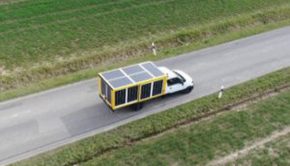How a Former McDonald’s Product Director Plans to Shake Up the EV Charging Sector
How a Former McDonald’s Product Director Plans to Shake Up the EV Charging Sector
Whether you’ve ordered a Dosa Masala burger in India, a Date and Custard pie in the United Arab Emirates, or a Filet-O-Fish, well anywhere, there’s a good chance you’ve used a McDonald’s self-service kiosk.
The ubiquitous terminals are simple to use. That ubiquity and intuitiveness is very much absent from the electric vehicle charging landscape.
Having spent five years at McDonald’s fine-tuning those kiosks as a global product director, James Wehner now wants to do the same for EV charging in his new role as chief technology officer at Engenie, the U.K.-based charging specialist.
Today, the U.K.’s charging station operators range from oil majors to startups, with everything from car makers to utilities in between. Customers are presented with a fragmented mix of options, including subscription services, utility add-ons and pay-as-you-go systems.
Full interoperability appears to be some ways off, and for many potential EV buyers the landscape may be too confusing to bother engaging with.
“I don’t think anybody at the moment is actually thinking about the human being at the end of this process,” Wehner told GTM.
That’s not surprising considering the types of companies involved in the market, he said. “They’re about infrastructure, energy, oil … they’re not about the customer.”
“What you actually need to do is understand the thought process and mission of that individual at that time. I think the key thing in any one of these situations is reduce the cognitive stress on human beings to as little as possible.”
The biggest concern for potential EV customers
Range anxiety is no longer the biggest objection for potential EV consumers, Wehner believes; today, the experience of charging is more important.
Early EV adopters may be willing to put up with a complicated process for charging their cars, but it’s not going to wash in a mainstream market.
 James Wehner, Engenie’s new chief technology officer, was formerly global product director at McDonald’s. (Credit: Engenie)
James Wehner, Engenie’s new chief technology officer, was formerly global product director at McDonald’s. (Credit: Engenie)
Wehner offers up a personal experience of dipping to a 3 percent charge in his EV and pulling into a service station to fill it up. After following the instructions given by the provider, a company he’d never used before, he signed up only to be informed that the proprietary RFID card required would be posted in 3-5 working days.
In contrast, Engenie’s business model is to provide and operate public EV chargers that accept regular contactless bank cards.
Momentum for the British EV market
The U.K. government intends to phase out new internal combustion engine vehicles by 2035, a goal brought forward by five years this February. That means charging networks must get their houses in order fairly swiftly.
Ever-hardening views on climate change, painful air pollution data, and a generous tax break for corporate fleets have seen Britain’s EV sales numbers double so far in 2020. By the end of this year there will be nearly twice as many models available for sale in the U.K. market.
Even coronavirus has had a fairly muted impact. In April, sales of all cars in the U.K were down 97 percent, but sales of new EVs were down just 10 percent, according to the Society of Motor Manufacturers and Traders (SMMT).
The Android ecosystem of EV charging
The government in Westminster is eying interoperability between service providers as the next battleground.
Last September a clutch of European networks — including Engenie’s — announced they would start accepting one another’s customers, however BP Chargemaster, the U.K.’s largest network, is not participating.
Some of the reluctance to embrace interoperability comes from companies wanting to grab market share, Wehner said. In any case, the government has gone from gently encouraging interoperability to threatening to legislate for it if the industry cannot find an amicable solution on its own.
Wehner compares the current situation to smartphones, with Tesla playing the role of Apple and its ringfenced iOS while Engenie and others make up the Android ecosystem.
“We’re not Tesla: We need to work together so that our hardware works with other people’s hardware; so that our software and apps will work with other people’s hardware.”









